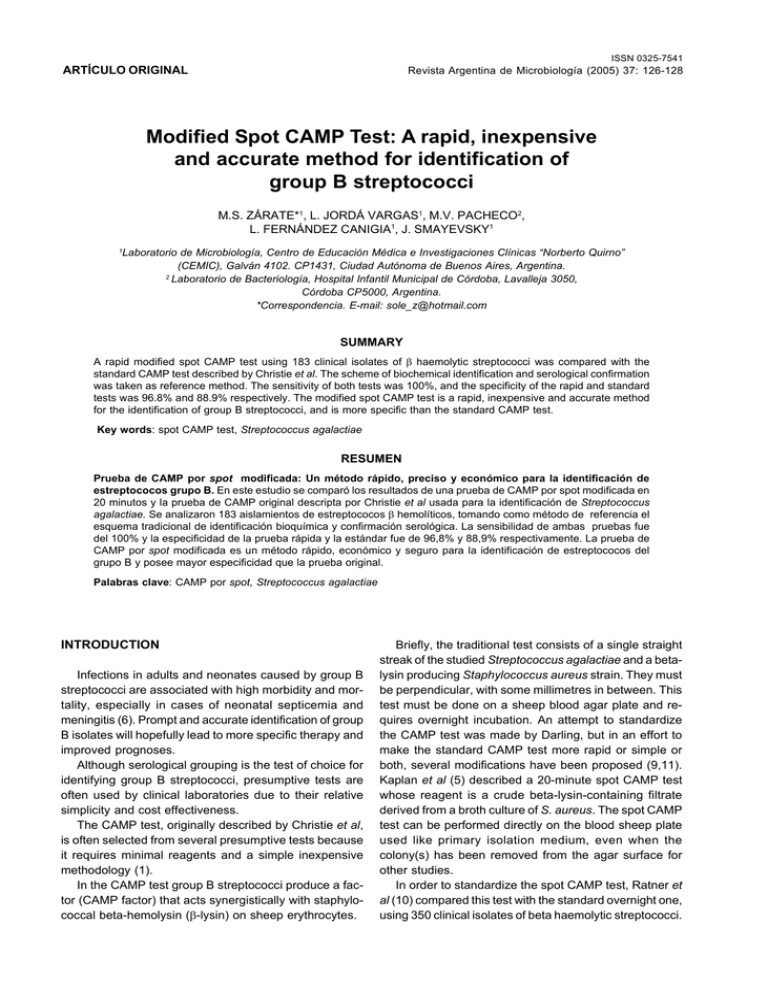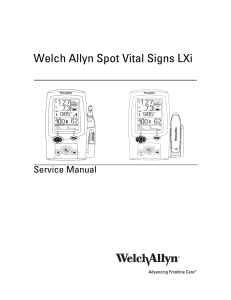Modified Spot CAMP Test: A rapid, inexpensive and accurate
Anuncio

126 Revista Argentina de Microbiología (2005) 37:0325-7541 126-128 ISSN Revista Argentina de Microbiología (2005) 37: 126-128 ARTÍCULO ORIGINAL Modified Spot CAMP Test: A rapid, inexpensive and accurate method for identification of group B streptococci M.S. ZÁRATE*1, L. JORDÁ VARGAS1, M.V. PACHECO2, L. FERNÁNDEZ CANIGIA1, J. SMAYEVSKY1 1 Laboratorio de Microbiología, Centro de Educación Médica e Investigaciones Clínicas “Norberto Quirno” (CEMIC), Galván 4102. CP1431, Ciudad Autónoma de Buenos Aires, Argentina. 2 Laboratorio de Bacteriología, Hospital Infantil Municipal de Córdoba, Lavalleja 3050, Córdoba CP5000, Argentina. *Correspondencia. E-mail: sole_z@hotmail.com SUMMARY A rapid modified spot CAMP test using 183 clinical isolates of β haemolytic streptococci was compared with the standard CAMP test described by Christie et al. The scheme of biochemical identification and serological confirmation was taken as reference method. The sensitivity of both tests was 100%, and the specificity of the rapid and standard tests was 96.8% and 88.9% respectively. The modified spot CAMP test is a rapid, inexpensive and accurate method for the identification of group B streptococci, and is more specific than the standard CAMP test. Key words: spot CAMP test, Streptococcus agalactiae RESUMEN Prueba de CAMP por spot modificada: Un método rápido, preciso y económico para la identificación de estreptococos grupo B. En este estudio se comparó los resultados de una prueba de CAMP por spot modificada en 20 minutos y la prueba de CAMP original descripta por Christie et al usada para la identificación de Streptococcus agalactiae. Se analizaron 183 aislamientos de estreptococos β hemolíticos, tomando como método de referencia el esquema tradicional de identificación bioquímica y confirmación serológica. La sensibilidad de ambas pruebas fue del 100% y la especificidad de la prueba rápida y la estándar fue de 96,8% y 88,9% respectivamente. La prueba de CAMP por spot modificada es un método rápido, económico y seguro para la identificación de estreptococos del grupo B y posee mayor especificidad que la prueba original. Palabras clave: CAMP por spot, Streptococcus agalactiae INTRODUCTION Infections in adults and neonates caused by group B streptococci are associated with high morbidity and mortality, especially in cases of neonatal septicemia and meningitis (6). Prompt and accurate identification of group B isolates will hopefully lead to more specific therapy and improved prognoses. Although serological grouping is the test of choice for identifying group B streptococci, presumptive tests are often used by clinical laboratories due to their relative simplicity and cost effectiveness. The CAMP test, originally described by Christie et al, is often selected from several presumptive tests because it requires minimal reagents and a simple inexpensive methodology (1). In the CAMP test group B streptococci produce a factor (CAMP factor) that acts synergistically with staphylococcal beta-hemolysin (β-lysin) on sheep erythrocytes. Briefly, the traditional test consists of a single straight streak of the studied Streptococcus agalactiae and a betalysin producing Staphylococcus aureus strain. They must be perpendicular, with some millimetres in between. This test must be done on a sheep blood agar plate and requires overnight incubation. An attempt to standardize the CAMP test was made by Darling, but in an effort to make the standard CAMP test more rapid or simple or both, several modifications have been proposed (9,11). Kaplan et al (5) described a 20-minute spot CAMP test whose reagent is a crude beta-lysin-containing filtrate derived from a broth culture of S. aureus. The spot CAMP test can be performed directly on the blood sheep plate used like primary isolation medium, even when the colony(s) has been removed from the agar surface for other studies. In order to standardize the spot CAMP test, Ratner et al (10) compared this test with the standard overnight one, using 350 clinical isolates of beta haemolytic streptococci. Spot CAMP test for streptococcal identification They found 99% and 100% of sensitivity and specificity respectively. Consequently, the Clinical Laboratory Standards Institute (ex National Committee Clinical Laboratory Standards) recommended the spot CAMP test for rapid identification of group B streptococci (7). However, the Kaplan test could not be used in a primary isolation medium different from the blood sheep agar, or in polymicrobial samples. In this study, a new modification of the spot CAMP test was analysed, which consisted in performing the spot and develop the rapid test on the same day of the isolation. We assessed the sensitivity and specificity of the modified spot and the standard overnight CAMP test for identification of S. agalactiae. Biochemical identification and serological confirmation were considered as reference method. MATERIALS AND METHODS Based on the prevalence of isolation at our laboratory (2), 183 beta haemolytic streptococci isolates (45 B group, 6 C group, 6 G group and 126 A group) were identified by conventional method, as described by Murray et al (6) including the serologic test confirmed by Lancefield precipitin test. The standard CAMP test was performed as described by Darling (3). A streak of S. aureus ATCC 25923 (a known strain that produces a high level of beta toxin) was done in agar sheep blood plate. The strains of streptococci to be tested were streaked in a straight line 2 to 3 cm in length and at a right angle to these inoculum, with care not to touch the staphylococcal streak. The plate was incubated at 37 °C for 18 hours, and a haemolytic zone observed in “arrowhead” was considered as positive result. Spot CAMP reagent preparation The spot CAMP reagent was prepared inoculating two 5-ml tubes of brain-heart infusion broth with a small amount of growth from a fresh subculture of S. aureus (ATCC 25923), and incubated overnight at 35 °C in ambient atmosphere. The two broth suspensions were mixed and sterilized by filtration in a laminar-flow biological safety cabinet using 0.45µm cellulose –acetate filter. Portions of 1 ml of the filtered-sterilized broth (spot CAMP reactive) were aliquoted into small tubes, with six-month expiration date when stored at –20 °C or lower temperature (7). Modified spot CAMP test Spot of microorganisms was done in agar sheep blood plate, and was incubated at 35 °C at 5% CO2-enriched atmosphere for at least 4 hours or until growth and haemolysis were evidenced. One drop or 10-µl loopful of spot CAMP reagent was placed next to a suspected group B streptococcal spot. The plate was incubated at 35 °C in ambient air (right side up to prevent the spot CAMP reagent from running over the plate surface) for 20 minutes. Transmitted light was used to detect a zone of enhanced haemolysis next to the spot. Initially negative reactions were reincubated for up to 30 minutes. The presence of a clear zone of enhanced haemolysis was considered a positive reaction. A negative reaction was the lack of haemolysis near to the spot of microorganisms in the presence of the spot CAMP reagent (staphylococcal haemolysin). 127 Enterococcus faecalis (ATCC 29212) and a strain previously identified as S. agalactiae were used like negative and positive controls respectively. The stability of sheep blood agar plate was measured on several occasions, on the same plate, for several days, which was kept in the fridge to be reused. The Mantel and Haenzel test was used for the statistical analysis of the spot CAMP and the standard CAMP tests (8). RESULTS All the S. agalactiae isolates were positive by spot CAMP test and standard CAMP test (sensitivity 100%). Only 4 Streptococcus pyogenes were positive by spot CAMP test (specificity 96.8%), and 14 by the standard method (specificity 88.9%) (Table 1) (p< 0.01). The reading time of the spot CAMP test need not be prolonged at any time for identification of S. agalactiae. The stability of sheep agar plates used for the test was 2 months at 4 °C. DISCUSSION Since certain conditions should be met for the satisfactory performance of the CAMP test, many authors have evaluated it using tube or disk (9,12). However, the original CAMP test described by Christie et al (1) is commonly used in clinical laboratories because of its simplicity. The NCCLS (7) suggests the use of the spot CAMP test described by Kaplan et al (5) for rapid identification of Streptococcus agalactiae, since this test has been previously validated by Ratner et al (10). Moreover, it would be very useful to make the primary isolation on a sheep blood agar plate. In this study, we suggest that the modified spot CAMP may be done on the same day of primary isolation. The stability of the sheep blood agar plate is another advantage of this test, which is an inexpensive option for routine diagnosis of S. agalactiae infections, and could be repeated on the same board during a month. Some studies have demonstrated that S. pyogenes have a positive CAMP reaction under certain conditions, Table 1. Spot and standard CAMP test of beta haemolytic streptococci (N: 183). Microorganisms N=183 S. agalactiae S. pyogenes Streptococcus group C Streptococcus group G N° 45 126 6 6 CAMP test positive “Spot” n/N1(%) Standard n/N1 (%) 45/45 (100) 4 /126 (3,2) 0/6 (0) 45/45 (100) 14/126 (11,1) 0/6 (0) 0/6 (0) 0/6 (0) (1) n/N, number of positive reactions / total analysed. 128 Revista Argentina de Microbiología (2005) 37: 126-128 particularly in anaerobic incubation (4,11). In our study, 14 S. pyogenes isolates were positive with the standard CAMP test, but not with the modified spot CAMP test. However, the synergy seen in the system of positive CAMP in S. pyogenes reaction has been long considered a false positive reaction caused by small parts of streptolysin O unoxidized (11). Notwithstanding that, Gase et al (4) demonstrated that Streptococcus pyogenes possess the gene that encoded an extracellular CAMP factor capable of participating in the positive reaction. In most cases, the haemolysis produced by these strains of S. pyogenes was less than that produced by S. agalactiae. The time around in the modified spot CAMP test could have been insufficient evidence to this test of the haemolytic effect of low level CAMP factor of S. pyogenes. Therefore, the modified CAMP test proposed has proved to be more specific than the standard; it could be done on the same day of microorganism isolation, and allowed to test several isolates on a single sheep blood agar plate. Thus, we consider this test a practical, accurate and inexpensive method for the identification of betahaemolytic streptococci at any clinical laboratory. Acknowledgements: We thank Dr Silvia Yudowsky from the Municipal Hospital of Córdoba, Argentina, for providing us with the strains, and Dr Hugo Krupitzki, CEMIC, Bs As, Argentina, for statistical counseling. REFERENCES 1. Christie R, Atkins NE, Munch-Petersen E (1944) A note on a lytic phenomenom shown by group B streptococci. Aust. J. Exp. Biol. 22: 197-200. 2. Dalibot D, Curcio A, Bantar C, Smayevsky J, Bianchini G (1992) Frecuencia de aislamientos de estreptococos Betahemolíticos del grupo C y G en exudado faríngeo y diferenciación entre “verdaderos” y “falsos” (S.anginosus). Triduo Bioquímico Científico Anual, organizado por la Asociación Bioquímica Argentina. Nº Resumen 56. Buenos Aires, Argentina. 3. Darling CL (1975) Standarization and evaluation of the CAMP reaction for the prompt, presumptive identification of Streptococcus agalactiae (Lancefield group B) in clinical material. J. Clin Microbiol. 1: 171-174. 4. Gase K., Ferretti J. J., Primeaux C., McShan W. M. (1999) Identification, cloning, and expression of the CAMP factor gene (cfa) of group A streptococci. Infect. Immun. 67: 4725-4731. 5. Kaplan RL, Dipersio JR, Barrett JE. (1985) Evaluation of the Spot-CAMP test for the rapid presumptive identification of group B streptococci. Am J Clin Pathol. 84: 216-219. 6. Kathryn LR, Whiley A, Beighton D (2003) Streptococcus. En: Murray PR, Baron EJ, Pfaller MA, Yolken RH (Eds). Manual of Clinical Microbiology 8th, Board, Washington, USA, p. 405-421. 7. National Committee for Clinical Laboratory Standards (2002). Baron E, Cox M, Heyliger M, Miller J, Ruoff K, Weinstein M, York M. Abbreviated identification of bacteria and yeast, approved guideline M35-A VOL 22 Nº 18, National Committee for Clinical Laboratory Standards, Wayne Pa. Estados Unidos de America. 8. Paz J (2002) Manual de Bioestadística. Ed. CEMIC. Galván 4102. Buenos Aires. Argentina. 9. Phillips EA, Tapsall JW, Smith DD (1980) Rapid tube CAMP test for identification of Streptococcus agalactiae (Lancefield group B). J. Clin. Microbiol. 12: 135-137. 10. Ratner HB, Lyndell SW, Stratton CW (1986) Evaluation of spot CAMP test for identification of group B streptococci. J. Clin. Microbiol. 24: 296-297. 11. Tapsall JW, Phillips E.A (1984) Streptococcus pyogenes streptolysin O as a cause of false-positive CAMP reactions. J. Clin.Microbiol. 19: 534-537. 12. Wilkinson HW (1977) CAMP-disk test for presumptive identification of group B streptococci. J. Clin. Microbiol. 6: 42-45. Recibido: 20/12/04 – Aceptado: 19/09/05



